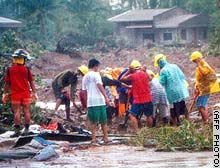"I am not here to talk about politics but what the people want."- GMA
On her State of the Nation Address (SONA) on monday, President Gloria Macapagal-Arroyo promised not to talk about politics. However, I noticed that her SONA obviously included politics. From the first to the last part of her speech, GMA has mentioned and praised different politicians. She acknowledged her supporters in the congress, number of soldiers and police and even those who tried to oust her.
In line with my observation, I quote a paragraph from yesterday's Inquirer issue:
"She vowed not to talk about politics but her State of the Nation Address amounted to what could be payback to her supporters- from generals and lawmakers to local executives and Church officials..."
It is clearly observed that Ms. Arroyo did not stick to her word--not to talk about politics.
When GMA broke her own vow--not to talk about politics, something popped up in my mind. I thought, if the president can't keep her word with that simple vow, what more with doing the numerous projects she proposed. This may imply that our president is not capable of keeping her promises. This generates doubt on the part of the Filipinos like me. I doubt if GMA will stick to her proposed projects such as making "super regions."
If only GMA delivered her speech without saying politics is not included when in fact it is, she could have not bore a negative impression to the people.
The next time Ms. Arroyo delivers SONA, if she still seats as the president, simple things such as this should be given importance. She should note that every detail that comes out in her mouth is being observed, commented and sometimes "cooked" (criticized).

 Photo 2
Photo 2  Photo 3
Photo 3
 Photo 5
Photo 5










